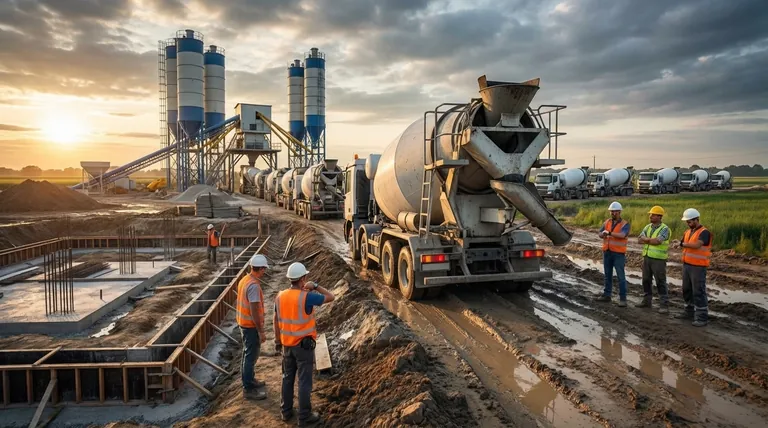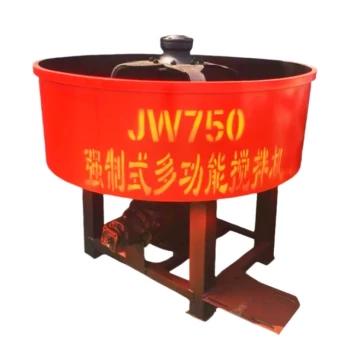The primary disadvantages of ready-mix concrete are logistical. They include a limited time window from mixing to pouring, a high dependency on the supplier's schedule, and the need for clear, stable site access for heavy delivery trucks. These factors reduce on-site flexibility compared to mixing concrete yourself.
Choosing ready-mix concrete is a trade-off. You exchange the labor, quality control challenges, and material waste of site-mixing for the logistical complexities and scheduling dependencies of relying on an external supplier.

The Core Challenge: Time and Logistics
Ready-mix concrete introduces external variables that are outside of your direct control. The success of your project becomes heavily reliant on planning, coordination, and predictable site conditions.
The Limited Time Window
Concrete begins to hydrate and harden the moment water is added at the plant. This chemical reaction cannot be stopped.
Delivery trucks have a finite window, typically around 90 minutes, to transport the concrete and discharge it before it becomes unworkable. Any delay due to traffic or on-site issues can jeopardize the entire batch.
Dependency on Supplier Schedules
Your project's timeline is now tied directly to the ready-mix supplier's availability. You are subject to their batching schedule, truck availability, and delivery routes.
This can be a significant constraint for projects requiring precise timing or for those operating in areas where supplier demand is high, potentially leading to scheduling conflicts or delays.
Site Accessibility and Conditions
Ready-mix concrete is delivered in extremely heavy trucks. The delivery path and the pour site itself must be able to support this weight without issue.
Poor ground conditions, narrow access roads, or overhead obstructions can make delivery impossible. This makes ready-mix impractical for many remote or difficult-to-access job sites.
Understanding the Financials and Flexibility
While ready-mix can reduce overall project costs through efficiency, it presents its own set of financial considerations and limitations.
Less Flexibility in Volume
You must order a specific quantity of concrete in advance. If you miscalculate and order too much, the excess is wasted material that you still have to pay for.
Conversely, if you run short, ordering a small additional batch can be prohibitively expensive and cause significant delays, potentially creating a "cold joint" where the new concrete doesn't bond properly with the already-hardened layer.
Higher Initial Material Cost
The per-cubic-yard cost of ready-mix concrete is typically higher than the cost of buying the raw cement, sand, and gravel yourself.
You are paying for the service, the quality control, and the convenience. This cost is often offset by reduced labor and faster completion times on larger projects, but it can make it less economical for very small jobs.
The Trade-offs: Control vs. Convenience
The decision to use ready-mix concrete hinges on what you are willing to manage yourself versus what you are willing to outsource.
What You Gain: Quality and Safety
The greatest advantage of ready-mix is guaranteed quality. The concrete is produced in a controlled, automated plant environment, ensuring consistent strength and performance that is difficult to replicate with manual mixing.
You also eliminate the significant physical strain and health risks associated with manually mixing concrete, such as back injuries and the inhalation of harmful cement dust.
What You Lose: On-the-Fly Adjustments
Once the truck arrives, you are committed to the mix you ordered. There is very little room for adjustment.
With on-site mixing, you have complete control to alter the water content, aggregate, or stop mixing immediately if a problem arises with your formwork or preparations. This flexibility is lost with ready-mix.
The Environmental Equation
The environmental impact is complex. Ready-mix plants centralize dust and noise pollution, which is beneficial for the job site itself and surrounding areas.
However, the large-scale production and fleet of heavy transport trucks contribute a significant carbon footprint. The choice shifts the environmental burden from the construction site to the production facility and the transportation network.
Is Ready-Mix Concrete Right for Your Project?
Choosing between ready-mix and site-mixed concrete depends entirely on the scale, location, and specific demands of your job.
- If your primary focus is large-scale efficiency and guaranteed quality: Ready-mix is almost always the superior choice for its speed, consistency, and reduced labor requirements.
- If your primary focus is a small project or a remote location: The logistical challenges, minimum order fees, and site access issues may make traditional site-mixing far more practical.
- If your primary focus is maximum control and flexibility: Site-mixing provides complete authority over the mix design and timing, which is critical for specialized or unpredictable work.
Ultimately, the right decision comes from a clear understanding of your project's unique logistical constraints and priorities.
Summary Table:
| Disadvantage | Key Impact |
|---|---|
| Limited Time Window | Concrete must be poured within ~90 minutes of mixing. |
| Supplier Dependency | Project timeline is tied to the supplier's schedule. |
| Site Accessibility | Requires stable ground and clear access for heavy trucks. |
| Volume Inflexibility | Risk of waste from over-ordering or high costs from under-ordering. |
| Higher Initial Cost | Per-unit cost is higher than raw materials for site-mixing. |
| Reduced On-site Control | Little to no ability to adjust the mix after delivery. |
Ready to find the right concrete solution for your project?
At GARLWAY, we specialize in providing construction machinery—including concrete mixers and batching plants—that give you the control and flexibility you need. Whether you're a contractor managing a large-scale project or working in a remote location, our equipment helps you overcome the logistical challenges of ready-mix concrete.
Let us help you optimize your concrete operations. Contact our experts today for a tailored solution!
Visual Guide

Related Products
- HZS75 Concrete Batching Plant Cement Mixer Price Concrete Mixer Bunnings Mixing Plant
- HZS120 Ready Mix Concrete Batching Plant Commercial Mud Cement Mixer
- HZS180 Ready Mix Concrete Plant for Foundations with Sand and Cement
- HZS35 Small Cement Concrete Mixing Batch Plant
- Ready Mixer Machine for Construction Ready Mix Machinery
People Also Ask
- How much weight can a cement mixer hold? A Guide to Choosing the Right Size for Your Project
- How does ready-mix work? A Guide to Efficient, High-Quality Concrete Delivery
- How do I choose a cement mixer? Find the Perfect Match for Your Project Scale and Power Needs
- Can you mix self leveling concrete in a cement mixer? Avoid Costly Flooring Mistakes
- What can you mix in a cement mixer? Unlock Its Full Potential for Concrete & Beyond



















